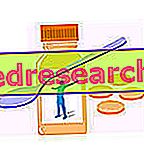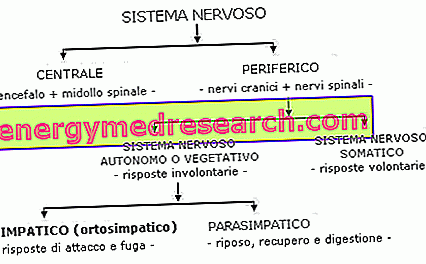Generality
When we talk about myositis we refer to a muscle inflammation that causes feelings of weakness and pain in the affected muscles.

To make a correct diagnosis of myositis, a careful physical examination is required, supported by blood tests, biopsy of the affected tissue and several instrumental tests.
Early intervention and if the myositis is not particularly severe, the therapy can have satisfactory results.
What is myositis?
The medical term myositis indicates a particular pathological condition, characterized by an inflammation of the muscles of the body.
When myositis is in progress, the muscle fibers that make up our muscles suffer deterioration. At the beginning, the damage is limited to causing weakness ( asthenia ) and muscle pain ( myalgia ) at the time of contraction; subsequently, it can also cause muscle atrophy .
Although, in most cases, myositis tends to resolve itself positively, it should be noted that when it is not treated properly it can have serious consequences.
What is muscle atrophy?
Muscle atrophy means a reduction in muscle mass (or tone), which significantly reduces the capacity of the affected muscles. In other words, an atrophied muscle is a weak muscle, as lacking in strength.
The most common causes of atrophy are, very often, linked to complete physical inactivity, immobilization of a limb (after a fracture), starvation or liver failure.
WHERE DOES MIOSITE ACT? MUSCLES AND NOT ONLY
Myositis mainly affects the proximal voluntary musculature, that is, all those muscles that allow movement and are close to the trunk.
Therefore, the areas most affected by the disorder are the neck, shoulders, hips, thighs and arms.

Figure: the muscles of the arm of a healthy individual (on the left) and of an individual with myositis (on the right). The reduction in muscle tone, ie atrophy, is evident. From the site: helpmedico.com
Furthermore, in some particular forms of myositis, or when the treatments are not adequate, the voluntary distal limb muscles (for example, at the calf level), the smooth muscles (of the respiratory, circulatory and digestive systems) may also be involved. the joints and ligaments .
Causes
There are many forms of myositis. Their classification is based, for reasons of comfort, on the triggering causes. It should be pointed out that not all forms of muscle inflammation expand and affect more muscles; some, in fact, remain confined to the point of onset.
THE TYPES OF MIOSITE
- Idiopathic inflammatory myopathies . They include all the rare forms of myositis that cannot be explained etiologically (the cause cannot be identified). The term "idiopathic" means just that. The main forms are: idiopathic polymyositis, idiopathic dermatomyositis and included body myositis . Very often, these forms of myositis possess characteristics of autoimmune diseases, in which the immune system, instead of defending the organism, turns against it, attacking it.
- Infectious myositis . Some viruses, parasites and bacteria can invade our body and our muscles causing myositis. The most commonly involved microorganisms are influenza viruses, some respiratory tract viruses, the AIDS virus, the Trichinella parasite and staphylococcal bacteria . The latter are widespread especially in countries with a tropical climate and where health care is insufficient. Viruses, on the other hand, tend to manifest themselves in acute forms.
- Myositis associated with other diseases . Some myositis occur in association with other diseases. Diseases associated with myositis:
- Systemic lupus erythematosus
- Myasthenia gravis
- Hashimoto's thyroiditis
- Ovarian cancer
- Lung cancer
- Breast cancer
- Scleroderma
- Neoplasms in general
- Ossifying myositis . This type of inflammation is caused by the formation of an abnormal bone mass within one or more muscles. The reasons for this anomaly are very often due to severe muscle trauma, in which there is a very deep hematoma. The ossifying myositis remains confined to the site where the bone mass was formed.
- Drug-induced myositis . Some drugs or certain drug combinations can have side effects that can cause muscle inflammation.
These consequences have been found with two types of medicines: those used to lower cholesterol (statins, atorvastatin, lovastatin and simvastatin) and zidovudine, an antiviral used against the AIDS virus.
Epidemiology
From the epidemiological point of view, the myositis that arouse more curiosity are idiopathic, because, failing to understand the causes, we try at least to know the incidence.
These rather rare forms affect one person per 100, 000, with a preference for the female sex. In fact, twice as many women are affected.
Although they can arise at any age, dermatomyositis and polymyositis make their appearance especially between the ages of 40 and 50, while the inclusion body myositis occurs especially between the ages of 50 and 60.
Symptoms and Complications
The symptoms common to all forms of myositis are, in fact, three:
- Muscle weakness ( asthenia )
- Muscle pain ( myalgia )
- Muscle soreness
To these symptoms, depending on the triggering cause, other manifestations can be added, sometimes even very serious and debilitating.
IDIOPATIC INFLAMMATORY MYOPATHIES
In the early stages, dermatomyositis, polymyositis and included body myositis cause painless muscle weakness . After a few weeks, muscle soreness and pain appear.
As already mentioned, initially only the proximal voluntary muscles are involved; then, when the disease gets worse, there is also an interest in the distal and smooth muscles.
Polymyositis . As long as myositis is limited to the proximal muscles, the patient complains of fatigue, myalgia and difficulty in performing very simple movements, such as making scales, getting out of the chair, lifting a weight, etc.
When myositis reaches the distal and smooth muscles, myalgia and motor-type difficulties come to involve the hands and digestive system.

Figure: signs of scleroderma in a patient with dermatomyositis.
From the site: the-rheumatologist.org
The sick, at this stage of the disease, suffer from dysphagia (complicated swallowing) and have problems writing, buttoning up a shirt, using a computer keyboard, etc. It is rare that the muscles of the eyes, face, heart and sole of the foot are compromised; it is equally unusual for tendons to be affected.
In the more advanced and more serious stages of the pathology, the muscles appear soft on palpation and may undergo atrophy.
Dermatomyositis . The characteristic that distinguishes dermatomyositis is that this form also occurs at the skin level.
In fact, the typical cutaneous signs, which accompany myalgia, asthenia and muscular atrophy, are the so-called skin rash (or rash ) and scleroderma .
A skin rash in progress causes reddish-purple spots on the eyelids, chest, face and joints (knee and shoulder, in particular).
Scleroderma, on the other hand, causes multiple disorders not only on the skin, but also on internal organs, with sometimes serious consequences.
The effects of scleroderma:
- Thick and shiny stiff skin
- Reynaud's phenomenon
- Cutaneous calcinosis
- Swellings on hands and feet
- Cardiopulmonary problems
- Hyperpigmentation and hypopigmentation
- Dry mouth and eyes
- Arthritis
- Dysphagia
- Esophagitis
- Digestive difficulties and gastrointestinal ulcers
Body myositis included . When it occurs, it causes weakness of the proximal muscles of the legs (first) and of the arms (then). As the disease progresses, the distal muscles at the level of the hands and feet and the smooth ones of the esophagus (with consequent dysphagia) are also involved. Muscular atrophy is likely to occur.
INFECTIOUS MYOSITIS
In addition to presenting with pain and muscle weakness, infectious myositis is also characterized by:
- High fever
- Chills of cold
- Sore throat, cough
- fatigue
- Skin redness
- A runny nose
This symptomatology can sometimes vary and become enriched with other clinical signs, depending on the infectious agent that caused the myositis. For example, if the triggering organism is Trichinella, the patient may also suffer from diarrhea and vomiting; if instead at the base there is a virus of the respiratory tract, the patient can suffer from more or less serious respiratory crisis.
MYOSITIS ASSOCIATED WITH OTHER PATHOLOGIES
When a certain pathology also causes myositis, the patient shows both the symptoms of the responsible pathology and those of muscular inflammation.
In other words, the symptoms vary depending on whether, for example, there is a myasthenia gravis, a Hashimoto's thyroiditis, an ovarian tumor, etc.
An interesting fact, regarding the association between myositis and tumors, is the following: it seems that 10-20% of neoplasias trigger muscle inflammation similar to dermatomyositis.
OXIFYING MIOSITE
The formation of abnormal bone mass causes weakness and pain on palpation of the affected muscle. Symptoms do not appear immediately, but several weeks after muscle trauma.
A particular sign, which usually anticipates ossifying myositis, is the appearance of a post-traumatic hematoma.
MYOSITE INDUCED BY DRUGS
In addition to muscle pain and fatigue, the patient also suffers from frequent cramps . The appearance of symptoms in this type of myositis occurs immediately after taking the drugs responsible for the disorder.
NB: please note that myositis is a possible side effect of zidovudine (antiviral used against AIDS) and some drugs that reduce cholesterol. Therefore, this side effect is not always present.
COMPLICATIONS
Before talking about the possible complications due to myositis, it should be specified that not all the types of muscle inflammation described so far are equally dangerous. In fact, there are more serious forms (such as idiopathic inflammatory myopathies and myositis associated with other pathologies) and less severe forms (such as ossifying myositis, drug-induced myositis and infectious ones).
The most serious forms can have very dangerous complications for the patient; just think that cardio-respiratory problems caused by scleroderma can degenerate into heart block, pericarditis, myocardial infarction etc.
The less severe forms, on the other hand, involve a limited number of muscles.
Complications of the most serious myositis:
- Gastrointestinal ulceration
- Pneumonia
- Heart attack
- Cardiac arrhythmia
- Pericarditis
- Myocardial infarction
- Highly compromised ability to swallow and digest
Diagnosis
An objective examination supported by instrumental and laboratory tests is necessary to establish the diagnosis of myositis.
EXAMINATION OBJECTIVE
During the physical examination, the initial step involves interrogating the patient on the symptoms experienced. At this stage, the important information to be collected from the patient's voice is: location of muscle pain, feeling of weakness and how long these disorders have been present.
In the next step the doctor investigates the patient's clinical history (current and previous diseases and disorders) and the possible use of drugs.
The third and final step is the control, on palpation, of the muscles; often, the muscles affected by myositis are tender, painful and as if they had granules inside them.
If these three checks lead us to believe that this is indeed a muscle inflammation, we proceed with more thorough examinations.
LABORATORY EXAMINATIONS
Laboratory exams consist of:
- Blood tests
- Muscle biopsy
Blood tests . By simply drawing blood, it is possible to measure the quantities of certain enzymes and molecules ( antibodies, auto-antibodies and tumor antigens ), which reach certain levels in a healthy patient and reach others in myositis patients.
For example, the enzyme creatine kinase is quantified, which in patients affected can be 50 times higher than normal; if muscle inflammation is due to an infectious agent, specific antibodies are also searched; the presence of auto-antibodies can also be probed, given that some myosites have an autoimmune origin; finally, certain tumor antigens are measured to determine if myositis may be due to a neoplasm.
Muscle biopsy . It consists in the collection and analysis of a small sample of muscle tissue, belonging to the patient under observation. Microscopic vision of muscle fibers allows us to see whether inflammation is taking place within the cells.
It is considered, due to its high reliability, the definitive examination.
INSTRUMENTAL EXAMINATIONS
The possible instrumental exams are:
- Electromyogram . It is used to measure the electrical activity of muscles. It is not at all invasive.
- Nuclear magnetic resonance ( RMN ). It is usually used not so much to recognize a myositis, but to identify the best place to perform the biopsy. It is not an invasive exam
- X-ray x-ray . It is used when, from the physical examination, the possibility emerges that at the origin of the symptoms there is an ossifying myositis. The test uses harmful ionizing radiation.
- Computerized axial tomography ( TAC ). It is useful when infectious myositis is suspected. This test also uses ionizing radiation.
Treatment
To establish the most appropriate therapy, it is essential to clarify the precise causes of the origin of myositis. In fact, successfully treating a myositis without knowing its etiological origin is very unlikely.
The therapeutic approaches are based on pharmacological treatments supported by simple behavioral countermeasures.
CARE OF IDIOPATIC INFLAMMATORY MYOPATHIES
Polymyositis and dermatomyositis : the pharmacological choice, for these two idiopathic forms of myositis, is very wide. It usually begins with the administration of corticosteroid i (for example, prednisone); if these do not work, then immunosuppressive drugs (for example, methotrexate or azathioprine) and intravenous immunoglobulin injection are switched.
The first effects of the treatment begin to be seen one or two months after the start of treatment and the results are generally satisfactory.
Included body myositis : the pharmacological treatments are the same as for polymyositis and dermatomyositis. However, the results are much less satisfactory. Most patients with this form of myositis tend to worsen their health over the years.
| drugs | Route of administration | Purpose |
Corticosteroids:
|
| They reduce the autoimmune response. Furthermore, they serve to maintain muscle strength and prevent muscle atrophy. |
Immunosuppressants:
|
| They reduce the autoimmune response, which affects the health of the organism. |
| Immunoglobulins |
| They reduce the autoimmune response. |
CARE OF INFECTIOUS MIOSITE
When myositis is infectious, it is advisable to stay at rest and to take analgesic (anti-pain) and anti-inflammatory drugs. However, next to these general treatments, the patient also needs specific care for the infectious agent that caused the myositis .
Some examples: in cases of Trichinella infection, the patient must take mebendazole or albendazole, because this is the only way to "kill" the parasite; in cases of bacterial infection, it is essential to administer antibiotics to eliminate the bacterium.
Mild infections can be exhausted in 4-7 days; severe ones can take up to 3 weeks to cure.
CARE OF MYOSITIS ASSOCIATED WITH OTHER PATHOLOGIES
When myositis is due to other pathologies, the most appropriate therapy must be set up to resolve both muscle inflammation and the disease that gives rise to the whole. Simply treating only myositis would offer only temporary benefits, as sooner or later the symptoms would reappear.
In light of this, the treatments vary from case to case. For example, if at the origin there is systemic lupus erythematosus, it is necessary to opt for immunosuppressive drugs; if instead there is a lung cancer, anti-cancer drugs should be administered.
CARE OF OXYFACTIVE MIOSITIS
Usually, in cases of ossifying myositis it is necessary to wait until the bone mass disappears by itself. This occurs within a few months. If this does not happen (rare), surgery is performed for removal.
CARE OF MYOSITIS INDUCED BY DRUGS
In drug-induced myositis, the interruption of drug therapy responsible for the disorder is sufficient to resolve muscle inflammation. However, it takes several weeks, if not months, to appreciate the effects.
Prognosis and prevention
For an individual affected by myositis, the prognosis depends primarily on the cause and, secondly, when and how care is taken.
THE FORMS LESS SERIOUS
The ossifying myositis and the drug-induced myositis always have a positive prognosis, provided that the causes are correctly interpreted and the right therapeutic countermeasures are made.
For infectious myositis the speech is more complicated and requires special considerations: an early diagnosis of the disorder and a timely cure cause the prognosis to become positive; conversely, a late or incorrect diagnosis and an inappropriate cure make the prognosis negative.
This second possibility is a rare event (so much so that infectious myositis has been included among the less serious forms), but sometimes possible.
THE MOST SERIOUS FORMS
Idiopathic inflammatory myopathies and myositis associated with other diseases are among the forms of myositis with a potentially negative prognosis. These can also have serious complications and therapy may not always be effective, even when it is drastic (as in the case of a tumor).
Infectious myositis not treated properly and caused by viruses and dangerous microorganisms, such as the AIDS virus, must be considered serious.
PREVENTION
Preventing certain forms of myositis is possible. That's how:
- Make the flu vaccine annually (recommended for people with a weak immune system)
- Cook the meat well (the trichinella parasite is found in raw meat)
- Don't use drugs, in this case the injectable ones, and use the condom correctly in case of occasional intercourse
- Keep the skin clean
- Do not take drugs recklessly, especially those associated with myositis



